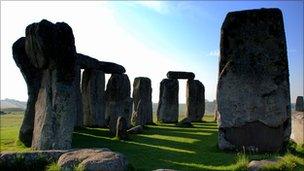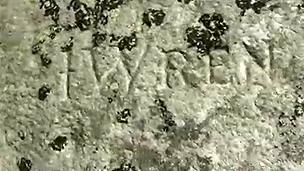Laser scan for Stonehenge secrets
- Published

Stonehenge is being scanned using modern laser technology to search for hidden clues about how and why it was built.
All visible faces of the standing and fallen stones, many of which are obscured by lichen, will be surveyed.
Some ancient carvings have previously been found on the stones, including a famous Neolithic "dagger".
The survey is already in progress and is expected to finish by the end of March.
"The surfaces of the stones of Stonehenge hold fascinating clues to the past," said English Heritage archaeologist Dave Batchelor.
The team will be looking for ancient "rock art", but also for more modern graffiti, in a comprehensive survey of the site.
Among those who have left their mark in the stones is "Wren" - thought to be Sir Christopher Wren, the architect who designed London's St Paul's Cathedral.
Wren's family had a home nearby, where he is known to have spent time, adding credibility to the claim.
The new survey will be the most accurate digital model ever for the world famous prehistoric monument, measuring details and irregularities on the stone surfaces to a resolution of 0.5mm.
The previous survey in 1993 was photographic, and only measured to an accuracy of about 2cm.
"This new survey will capture a lot more information on the subtleties of the monument and its surrounding landscape," said Paul Bryan, head of geospatial surveys at English Heritage.

Graffiti on one of the stones is thought to have been made by Sir Christopher Wren
Laser scanning is also being used to map the earthworks immediately around the stone circle, and the surrounding landscape, as part of a wider project.
English Heritage has proposed a new £25m visitor centre at Stonehenge and closing parts of the A344, which runs just yards away from the landmark.
Government funding was withdrawn last year, but the Heritage Lottery Fund has promised £10m. English Heritage is seeking additional funds and is confident of raising the money it needs.
English Heritage archaeologist Dave Batchelor illustrates the aims of the survey, external in a video by 360production
- Published28 September 2010
- Published22 July 2010
- Published17 June 2010